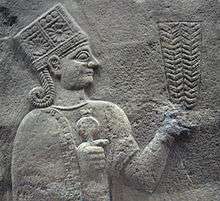Ḫepat
Ḫebat, also transcribed Khepat, was the mother goddess of the Hurrians, known as "the mother of all living".[1]
Hebat | |
|---|---|
| Other names | Khepat |
| Spouse(s) | Teshub |
| Children | Sarruma Alanzu |
Mythical family
Hebat was married to Teshub and was the mother of Sarruma and Alanzu as well as mother-in-law of the daughter of the dragon Illuyanka.
Name derivation

It is thought that Hebat may have had a Southern Mesopotamian origin, being the deification of Kubaba, the founder and first ruler of the Third Dynasty of Kish. The name may be transliterated in different versions: Khepat with the feminine ending -t is primarily the Syrian and Ugaritic version.
In the Hurrian language, Ḫepa is the most likely pronunciation of the name of the goddess. In modern literature, the sound /h/ in cuneiform sometimes is transliterated as kh.
Arinniti
The Hittite sun goddess Arinniti was later assimilated with Hebat. A prayer of Queen Puduhepa makes this explicit:
To the Sun-goddess of Arinna, my lady, the mistress of the Hatti lands, the queen of Heaven and Earth. Sun-goddess of Arinna, thou art Queen of all countries! In the Hatti country thou bearest the name of the Sun-goddess of Arinna; but in the land which thou madest the cedar land thou bearest the name Hebat.[2]
Widespread veneration
Ḫepat was venerated all over the ancient Near East. Her name appears in many theophoric personal names. A king of Jerusalem mentioned in the Amarna letters was named Abdi-Heba, possibly meaning "Servant of Ḫepat".[3]
See also
- Hurrian mythology
References
- Beckman, G.: Pantheon A. II. Bei den Hethitern. In: Edzard, D. O. et al. (Hrsg.): Reallexikon der Assyriologie und Vorderasiatischen Archäologie. Munich, 2010.
- Bach, Alice Women in the Hebrew Bible Routledge; 1 edition (3 Nov 1998) ISBN 978-0-415-91561-8 p.171
- Donald B. Redford, Egypt, Canaan, and Israel in Ancient Times, Princeton University Press, 1992 p.270.